
Once upon a time, before human civilization exploited the world to suit their whims, there are natural wonders that are so magnificent they defy the wildest imagination. Wonders that make you believe that magic exists. Rare treasures that make you step back and question why we are destroying our world. A few weekends ago, we considered ourselves fortunate to see and experience the purity, beauty, and danger of a hidden, untouched, and natural masterpiece in Samar, Philippines.
Together with fellow bloggers Gly of Chasing Potatoes and Kara of Traveling Up, we embarked on this extremely challenging journey to witness one of the most beautiful and primal secrets of our country. Guiding us was Joni Bonifacio of Trexplore the Adventures, one of the Philippines’ foremost, most qualified, and professional caving and canyoneering outfitters.
We started off with a huge breakfast that Rhine, Joni’s wife, prepared for us, knowing that we need all the energy we can get for this adventure. In fact, the way to Pinipisakan Falls was already an adventure in itself. After alighting at the town of San Jorge, contracting habal-habal drivers, and securing our canyoning/caving equipment, we climbed aboard their roofed habal-habals.
The 30-minute ride itself was not easy. As of this writing, many sections of the road towards our jump-off point was unfinished. The bumpy road threatened to topple down our motorcycle, and at times, we had to get down so the driver can navigate his machine through the thick mud.
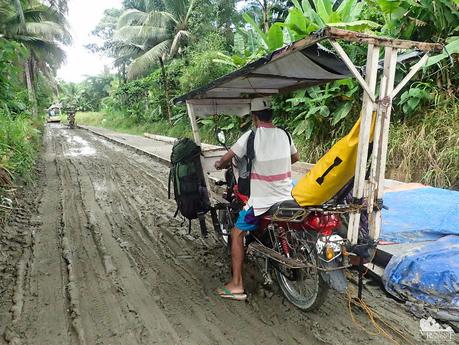
Blanca Aurora River
But they are driving on these roads every day. So, half an hour later, we safely arrived at Barangay Blanca Aurora, a barangay located right at the fringes of Samar Island’s center. After a light snack of squid balls and tempura, we descended down a flight of stairs towards the Blanca Aurora river so we could start the second leg of this adventure.
Check out the long dugout canoe. It rides low on the water, and without outriggers, it is very sensitive to its passengers’ movement. Our experienced boatmen assured us we’re not going to tip over. But with all our heavy equipment plus the passengers in this flimsy boat, we were not really convinced. Hehehehe!
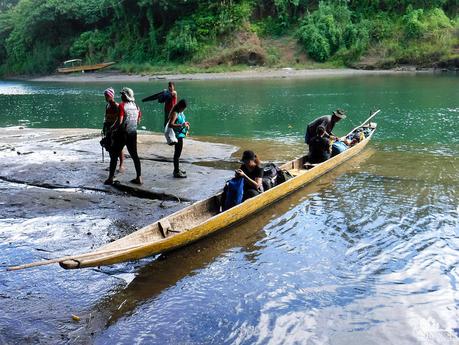
With everyone and our equipment on board, we started our river cruise to a doroongan deep within Samar’s jungles. Going against the strong current of the Blanca Aurora river was not easy for the small boat’s engine.
Sir Joni and Kara’s boat was more stable thanks to its small bamboo outriggers. The drag sacrificed its speed though. Our boat’s slimmer profile allowed us to cruise faster by a few knots.
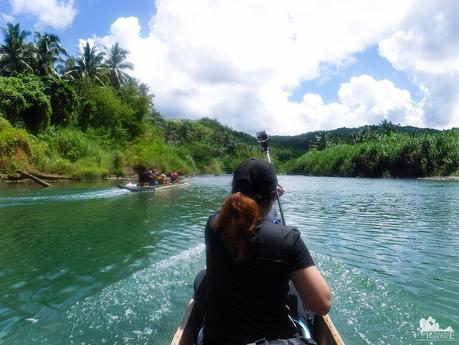
Thankfully, the weather was quite good; and in most parts, the Blanca Aurora river was calm. In fact, in many places, it was so calm that the surface was almost glass-like.
Locals use these boats to ferry people and goods to far-flung communities that line up the river. The last hub of commerce here is Barangay Blanca Aurora, which was our jump-off point.
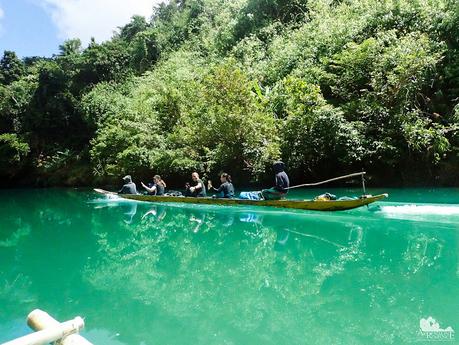
At times though, our boatmen had to shut off the engines, hop out of the canoe, and pull the boat across shallow water of less than a foot in depth. Yes, with us and our equipment in it! Several times, we asked if we could help, but our shy boatmen insisted that we stay on the boat.
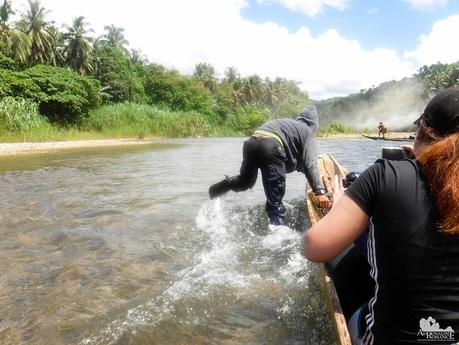
The Blanca Aurora river is a vital artery in this region in addition to being a “highway.” Primarily, it is a fishing ground for the locals, who still subsist on crayfish, crab, and fish that inhabit these waters. Of course, where there’s water, there’s also recreation. We found these young kids enjoying a river cruise. We also waved to a small group of ladies happily washing clothes in the river while their spouses took a morning bath nearby.
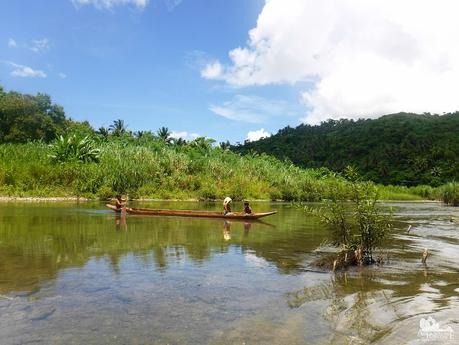
As we left the last traces of civilization behind, we found these strange-looking rocks along the river. They look like bricks that are neatly cut and stacked on one another. But would you believe they are actually natural and not cut or sculpted by man? Wow! The wonders of Mother Nature!
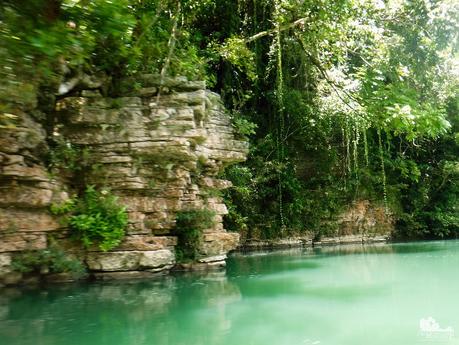
The boat ride wasn’t all smooth. Many times, we had to power up and fight against strong, rushing rapids. Water sloshed inside the boat as we fought through the gurgling, angry waters. We had to help scoop the “bilge” water up using an old dipper.
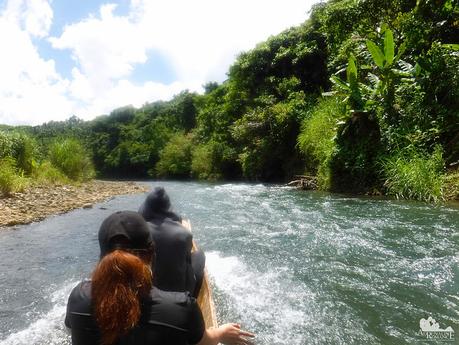
As we cruised towards the center of Samar Island, we were amazed at just how wild this place is. The jungle canopy is so thick that we couldn’t see anything after two layers of trees. Except for the prattle of our engine, there are no familiar man-made sounds here. Not even the occasional buzz of a chainsaw which we usually hear in highland or river communities. The only sounds were the loud murmurs of rushing water, the rustling of leaves, and the different calls of birds and insects.
We slowly realized that even a minor mishap here—a conked-out boat engine, a minor sprain, a companion passing out—could put us in peril. Yes, the place is beautiful and peaceful; but an accident or an ounce of disrespect can turn Nature into something cruel, indifferent, and deadly.
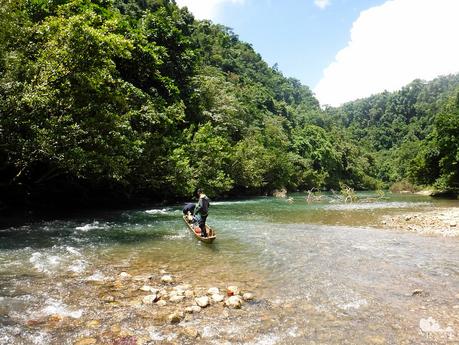
There was one time when we had to get out of the boat so that our boatmen could fully power up the vessel to fight against these raging rapids. It was a mesmerizing sight; they were definitely fighting the current, but they looked so calm and composed in doing it. You’ve gotta give a lot of respect to these locals.
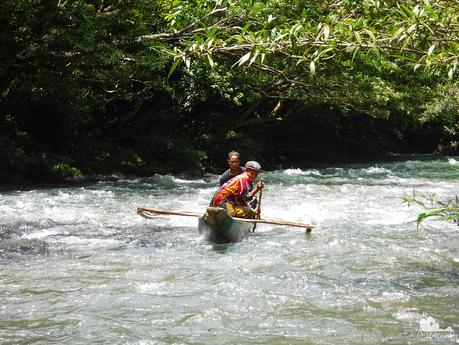
Nearing our destination, we passed by this ephemeral waterfall, its spidery curtain almost as fine as the sunbeams that filter through the forest canopy above it. Moss-covered stalactites hung from the cliff’s curvature.
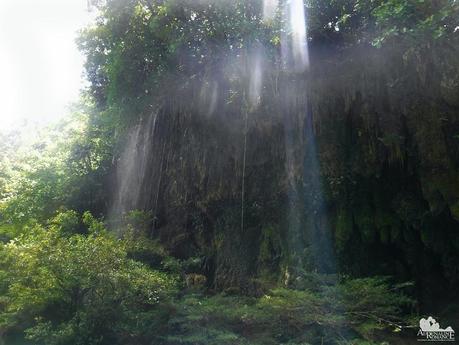
Finally, we turned towards a small, sandy inlet. We have arrived at the doroongan, which was also the starting point of the third leg of this adventure. In the local dialect, doroongan, probably derived from the Cebuano dongo-anan means “a place to dock.” We unloaded our equipment and distributed them to our porters.
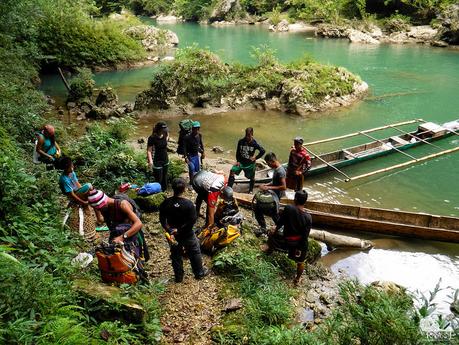
A Taxing Trek
As we climbed the adjoining hill, we had one last look at our only connection to the outside world. Will we make it? Will the boats be waiting for us when we return? Just look at how raw and primal this place is. If there’s a definition of true tropical wilderness, then this is it!
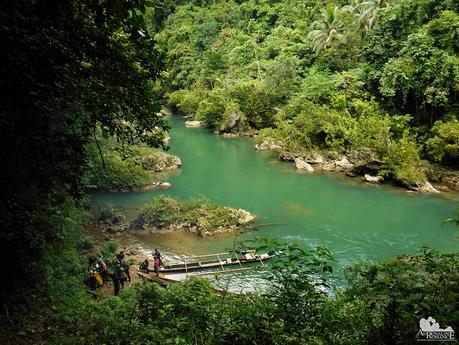
The third leg of this adventure involved a two-hour hike into the forest. Parts of the trail were quite exposed to the sun like this. Although the trail was somewhat easy with gentle ascents and descents, the hot mid-day sun soon took its toll on us.
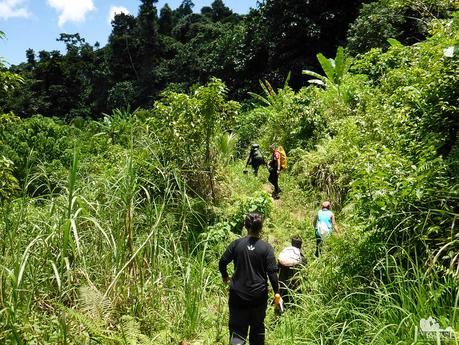
At times, we skirted along the edge of cliffs. We needed to be careful here, keeping our steps light, because the forest soil was quite soft. A heavy foot can dislodge the soil, causing the cliff to break up and plummet to the boulders below.
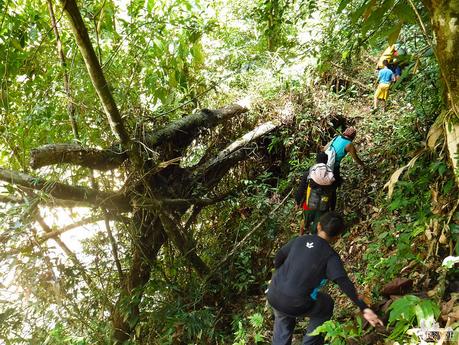
The suffocating heat of the day and the humidity of the forest made us want to jump into the cool waters of the river. We would get that wish the day after, Joni said. Those rapids are part of our return adventure.

Thankfully, we reached the shady canopy of the forest. Even though the final stretch required an exhausting climb on slippery stone and roots, the shade made it easier.
At this point, we will have to tell you, dear reader, that this place has a dark history and reputation. Remote, isolated, and mysterious, Central Samar has been known to be teeming with the dreaded patrols of the New People’s Army (NPA), the armed wing of the Communist Party of the Philippines. The dense jungle and unexplored nature of this place makes it an ideal hiding place of revolutionaries who are hiding from government forces. Locals tend to stay away from these areas out of fear of being executed by the NPA.
The brave soldiers of the Armed Force of the Philippines and the law enforcers of the Philippine National Police have hunted these rebels almost to extinction. But still, we don’t know if they still lurk in the dark…
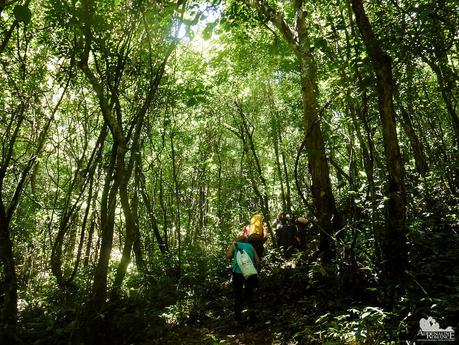
Finally, we heard the satisfying sound of rushing water accompanied by a steep descent. We arrived at our crude river campsite, which is nothing more than an open-air cottage made of discarded sacks and tarpaulins held together by severed tree limbs and branches. At last, we had a well-deserved rest.
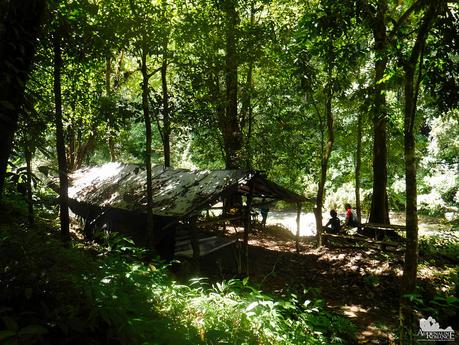
Pinipisakan Falls
After a hearty lunch, it was time to gear up so we could explore Pinipisakan Falls and Sulpan Cave. We donned on helmets and PFDs for safety. We also wore neoprene wet suits; the water of Pinipisakan Falls is quite chilly. The wet suits would keep us warm.
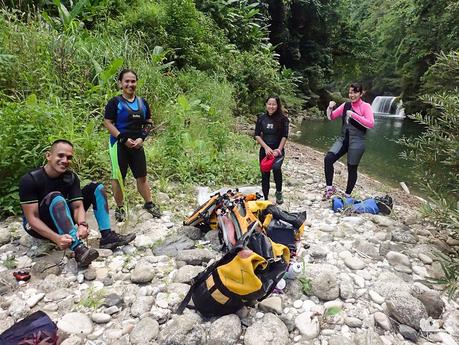
Everything set? Good! At around 2:30 PM, we jumped into the cold river and allowed the moderately strong current to take us to Pinipisakan Falls. Our hearts were pounding in anticipation as we approached the natural wonder right before us.
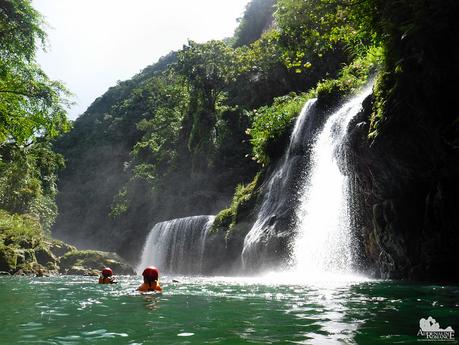
We climbed the boulder-filled riverbank opposite of the waterfall. Already, the beauty of Pinipisakan radiated like the warm and welcoming afternoon sunlight. As you can see, it’s not just one waterfall but a system of several waterfalls and tiers.
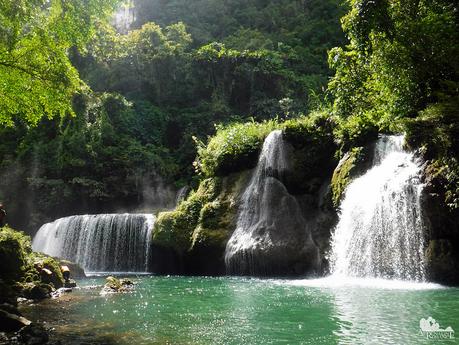
We climbed a few slippery boulders on the opposite side of Pinipisakan Falls to have a better view of its raw, exceptional beauty. And truly, it is absolutely dazzling—almost magical in its majesty. The ethereal fairy-tale kingdom that we’ve always read in children’s books and wish to see in real life is actually here.
Looking at Pinipisakan Falls gave us a deep and powerful sense of awe. The absolutely pristine and untouched condition of the waterfalls gave us a meaningful glimpse into Mother Nature’s virgin beauty before or after the effects of humanity’s global influence. Our world has incredibly exquisite places like these, but humanity’s greed has reduced many of these places into former shadows of themselves.
In this particular moment, we were very fortunate to have witnessed Pinipisakan Falls’ purity, and it will forever be treasured in our hearts.
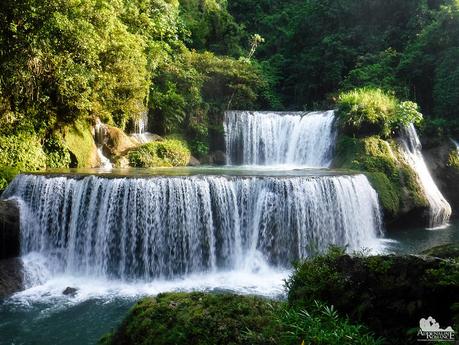
Of course, we couldn’t resist the temptation to have that mandatory couple pose. Hey, with me at the camera, it is seldom that I am included in a photo. Hehehe!
As you can see, Pinipisakan Falls is multi-tiered. Those main curtains are two of the lower tiers. Excess water flows down to the sides, creating minor waterfalls.
Now, you have to understand that Pinipisakan Falls is very rarely visited even by locals due to its remoteness, inherent natural danger, the area’s security situation, and the superstition that surrounds it. Indeed, we were some of the handful of people who were able to set foot in this place.
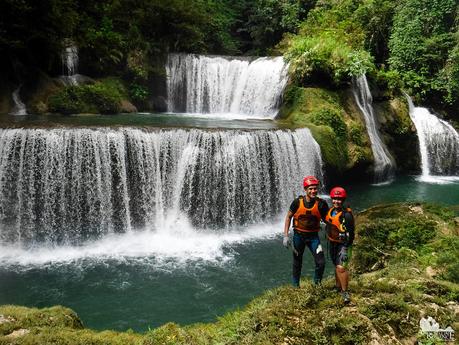
To get to the waterfalls itself, Joni and Entoy, our local guide, set up a safety line. This is necessary because the river’s current is quite strong at this area. You don’t want the current to push you to nearby, powerful rapids with huge rocks, do you?
One by one, we crossed the river, feeling its unlimited strength as we gripped the main line tightly. Joni attached an additional line to a simple sling-and-carabiner chest harness. In that way, if we accidentally let go of the main line, there is still an extra layer of safety; Joni can simply reel us in.
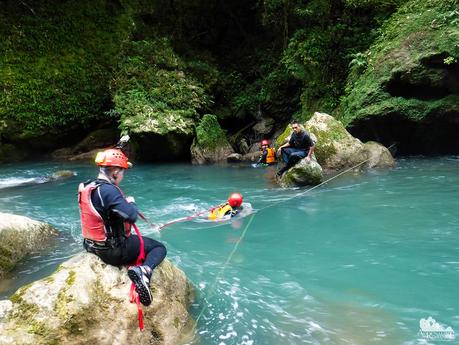
It takes more than “a little bit of care” to climb up the first level of Pinipisakan Falls. The areas that are untouched by the falls’ rushing waters but covered with moss are extremely slippery. On the other hand, our footwear can easily grip spots that are constantly bombarded by falling water. Yet, we had to exert some effort to go against the flow.
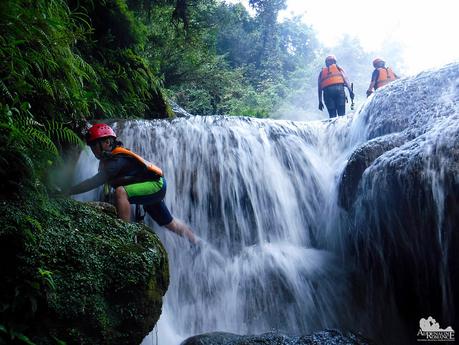
The second tier was a great place to relax; Sweetie and I called it the “Spa.” The pool is quite shallow; the water just reaches from the shins to the chest. Thus, it’s a nice place to lie down, close your eyes, and simply listen to the melody of the waterfall.
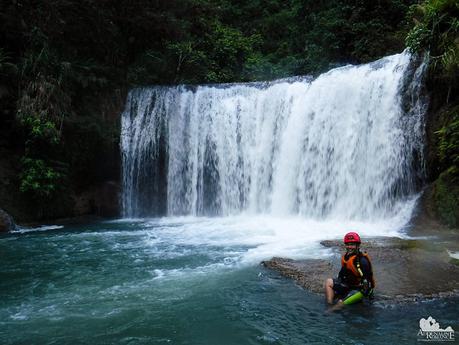
Or you can simply sit down below these mini-falls to have a massage. The force of the falling water feels good on the body.
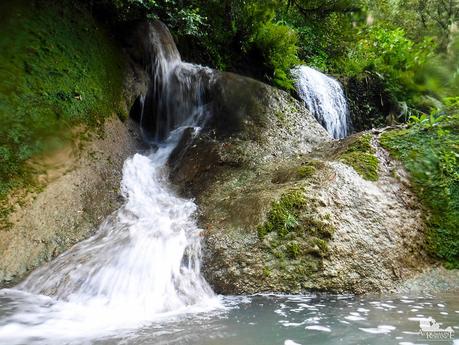
Joni stayed behind at the other side of the river so he could take a photo of us so you, readers, can see the scale. Can you see how tiny we look against the waterfall? For us, this is a poignant image; we are minuscule against the forces of nature.
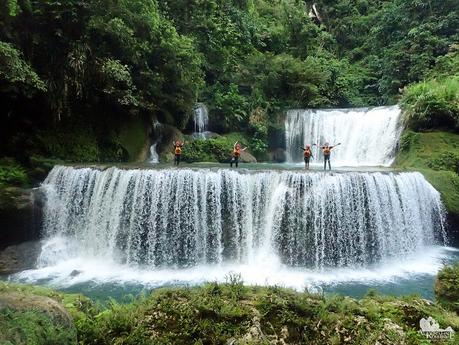
Joni and Entoy crossed the river, reeled back the safety line, then joined us so we could proceed with our adventure. Climbing to the third tier required a bit of a helping hand, especially for shorter people like Sweetie Sheila. Love you, sweetie! Hehehe! No problem for Gly though.
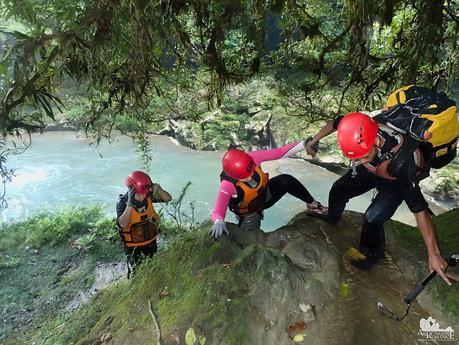
The third tier is what Joni called “The Garden of Eden.” And the name is indeed fitting. A large pool of blue-green water dominates the entire level, fed by a series of short, wide waterfalls. Sinewy and gnarly vines snake towards the water from overhanging tree limbs. Trees and foliage-covered cliffs tower all around us like everlasting guardians.
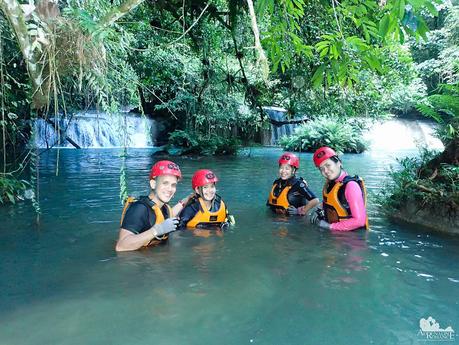
One of the nicest things about The Garden of Eden is that its pool is quite shallow. We also found a lot of water striders skating away from us as we sloshed towards the waterfall. Later at night, the girls caught a few freshwater shrimps here, which we cooked for dinner.
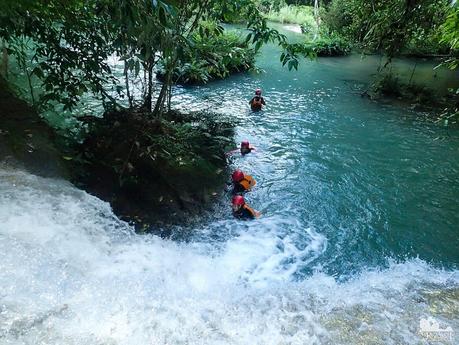
The only way up to the fourth level is to climb up a strong waterfall. We laboriously clawed our way up the flow, gripping on what little crevice and protrusions we can find.
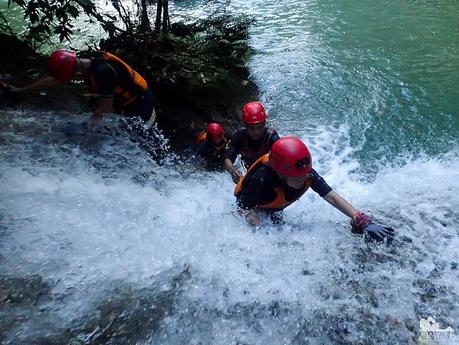
The fourth level primarily consists of broad, terrace-like slopes that break the water into uneven sheets of white. Surprisingly, walking on this slope is not slippery at all.
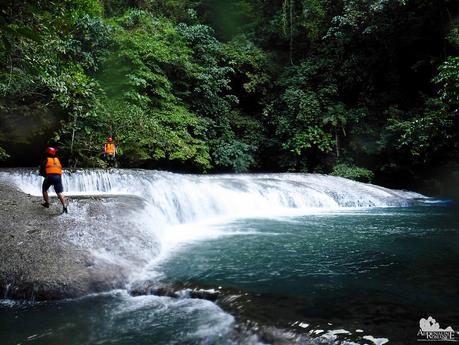
Look at that dazzlingly blue water! The word “water” doesn’t seem to fit it; water is too ordinary. Liquid blue topaz would be more like it!
Strangely, the water’s surface here is perfectly smooth although we can feel its flow. Only in places where something breaks its flow—such as the waterfalls’ slope or a jutting boulder—does the water breaks its glass-like smoothness.
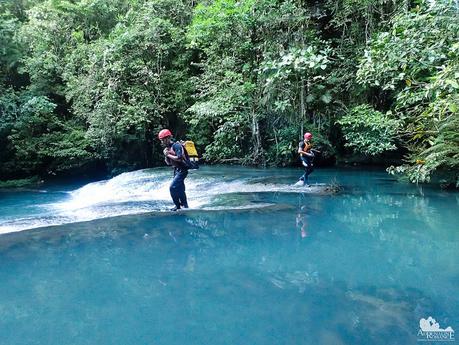
With cliffs towering hundreds of feet above us, the blue-green pool at the top of the fourth level seemed to be a dead end. However, up in the distance, partially covered with trees, we could see another waterfall and a dark—something. What could it be? Stand by for our next blog post.
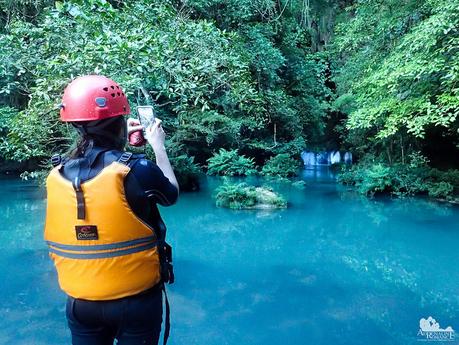
Beauty at its most primal. Nature at its purest. Pinipisakan Falls is among the grandest gems we’ve ever seen. But more than that, we saw how the Earth rewards us with overflowing magnificence if we simply step back and let Nature take its course—undisturbed and unhindered.
Itineraries and budgets will be in the Sulpan Cave blog post.
Important tips will be in the Blanca Aurora River blog post.
Contact Details
No one knows these places better than Joni Abesamis Bonifacio of Trexplore the Adventures. He is an extremely skilled and experienced canyoneering guide and cave master trained by top Italian and French speleologists. For trekking, canyoning, and caving guideship services, please get in touch with Joni using the following details:
- Mailing Address: Abesamis Store, Allen Avenue, Catbalogan City, Samar, Philippines 6700
- Cellphone Number: 0919-2943865 / 0927-6750062
- Landline: 063-055-2512301
- Email: [email protected] / [email protected]
- Website: Trexplore the Adventures
- Pinipisakan Falls-Sulpan Cave Cave Facebook Page: Pinipisakan Falls and Sulpan Cave
- Trexplore Facebook Page: Trexplore the Adventures
In Catbalogan City, there are several inns and hotels where you can stay for the night. However, Sir Joni also has guest rooms right in his home.
Getting to Catbalogan, Samar
Option 1
Take a direct flight from Manila, Cebu, or Davao to Tacloban. Once you arrive at Tacloban, ride a tricycle or taxi to the bus station. From there, you can ride a van or bus that will take you to Catbalogan. Do book with Joni in advance so that he can fetch you when you arrive in Catbalogan.
Option 2
Take a flight from Manila or Cebu to Calbayog. After arriving at the airport, head off to the bus terminal. Ride a van or bus that will take you to Catbalogan.
Option 3
From Cebu, ride a fast craft or a ferry to Ormoc. Across the port of Ormoc is a bus terminal. Ride a van or bus to Tacloban. Once you arrive at the Tacloban bus terminal, ride another bus or van to take you to Catbalogan.
For Option 1 and Option 3, we recommend you take a van rather than a bus for a faster and smoother ride. From Tacloban, you can reach Catbalogan in two hours. That’s the same length of time for a van ride from Ormoc to Tacloban. Buses take three hours per segment because they often stop along the way to pick up or disembark passengers.

